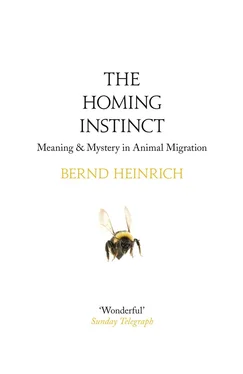For other animals and for us, home is a “nest” where we live, where our young are reared. It is also the surrounding territory that supports us. “Homing” is migrating to and identifying a suitable area for living and reproducing and making it fit our needs, and the orienting and ability to return to our own good place if we are displaced from it. Homing is highly specific for each species, yet similarly relevant to most animals. And the exceptions are illuminated by the rule.
The image of that albatross took on more meaning decades later, after I learned that the species mates for life and returns to the same pinpoint of its home, on some island shore where it was born, perhaps fifteen hundred kilometers distant. During the years when it grows to adulthood it may never be in sight of land. Seven to ten years after having left its home, it returns there to nest. It chooses to go there because of its bond. When a pair eventually have a chick in a nest of their own, each parent may travel over fifteen hundred kilometers of ocean to find a single big meal of squid, and after gathering up a full crop, it then flies home in a direct line; it knows where it is at all times.
The broad topic of homing subsumes many biological disciplines. In order to show the connections among all animals and us, I have interpreted the traditional use of an animal’s “territory,” or “home territory,” simply as “home.” We think of “home” primarily as a dwelling, but in order to be inclusive with other animals, I here consider their dwellings to be their homes as well. My application of the same terms to different species is deliberate for the sake of scientific rigor and objectivity, to acknowledge the continuity between our lives and those of the rest of life. I realize that this smacks to some of anthropomorphism, a pejorative term that has been used for the purpose of separating us from the rest of life. The behaviors involved in homing include drives, emotions, and to some extent also reason.
A home makes many animals’ lives possible: home is life-giving and sought after with a passion to have and hold. We humans are not thinking much about “home” for animals when we confine them in cages devoid of almost everything they need except air, food, and water in a dispenser, or when we destroy the habitat that contains the essentials of home for many species. So I begin our exploration of home and its implications with the example of the common loons, Gavia immer, birds that may live for decades. The collaborative study by three biologists, Walter Piper, Jay Mager, and Charles Walcott, reveals how important home can be — enough for fights to the death.
Loons spend winters in the open ocean, but a pair migrate from it and across the land back to their home, a specific northern pond or lake, to nest along its shore in the spring and raise one or two chicks out on the water. Starting almost immediately after ice-out and almost until freeze-up, camp owners along a lake routinely see “their” pair of loons year after year. It had long been assumed that the same individuals return each year and live as monogamous pairs on their strongly defended home territory. Huge surprises were in store after 1992, when techniques (using a boat, a strong light, and a net) were developed to capture loons and mark them with colored leg bands to identify individuals. In a long-term study of a population of loons in Wisconsin in a cluster of about a hundred lakes, it turned out that a pair of loons indeed returned year after year to their home. However, they were not always the same birds. As expected, given their longevity and reproductive potential, there were many “floaters,” those still without a home, and some of them routinely replaced members of a pair.
The floaters regularly visited different pairs at home at their respective lakes, and spirited vocal meetings resulted. These seldom led to fights, but they were not just friendly visits. These floaters were at first thought to invade others’ home grounds in order to make “extra-pair parenting” attempts (which in males refers to extra-pair copulations and in females to egg dumping into the others’ nests). However, DNA fingerprinting of the young loons from four dozen families produced not a single incident of extra-pair parenting. Instead, the visits by floaters were of an entirely different nature. They had an almost literally “deadly” purpose. The floaters were scouting — making assessments of both the worthiness of the others’ real estate and the defensive capabilities of the resident males — to gauge the possibility for future takeovers.
Loons nest on the ground along shorelines, if islands are not available. Shorelines, if low, are risky nesting places, not only because of potential flooding in early spring, but also because they are within easy reach of raccoons, skunks, and other predators. Most birds test what is a “good home” by direct experience — success in raising a brood there. Or, like the loons, they assess the experience of others: whether or not chicks have been raised there. So, if the territory does yield young, a floater, who apparently finds this out through scouting, may risk a fight in an attempted takeover to remove the defending male (if he achieves takeover, he automatically gets to keep the female who remains on her home). But the floater can risk an attack only when he is about four or five years old. When he is in prime physical condition and has much to gain — namely, a potential lifetime of home ownership — it makes sense to risk the battle. The older territory owner might then fight to the death, presumably because he has much to lose, and almost no chance to gain another home.
Loons may seem extreme in the lengths to which they go to secure a home, as do other birds that risk the hazards of migrating thousands of kilometers. Yet, in the movie I watched with rapt attention on board ship on the way to America at age ten, people on ponies shot arrows at others on a wagon train. All were emotionally charged, because each was fighting for something sacred, and therefore each was willing to risk his life, for defending or wanting a home.
We have learned much about thousands of animal species that twice annually risk their lives to migrate to an exact pinpoint, such as an oceanic island in the case of the albatross or a pond in the vastness of a continent in the loon’s. They open a window with a broad view onto our unending quest into the mysterious minds of animals, and in the process they illuminate our own. How does one tie the vastness that includes other animals, and so much that affects us personally and socially, together into a story?
Writing this book reminded me of when, after riding more or less unconscious in the slipstream of history for over fifty years, I started putting down stones chosen from a vast array of differently shaped fieldstones to build a house foundation. I couldn’t chop them to size or knock the edges off so that they would fit into the inevitable empty spaces to make neat connections. Nor did I want to shape them, like bricks, to make a tidy but artificial structure. The stones found in nature, like facts, are endlessly numerous, wild, and complex. As the famous British geneticist and evolutionary biologist J.B.S. Haldane quipped, “My own suspicion is that the universe is not only queerer than we suppose, but queerer than we can suppose.” I hope to give here a view of some of the “stones” of homing, and their origins, and how they apply in real life.
Homing is central to many aspects of our and other animals’ lives. To understand the meaning of home, like any other phenomenon, it helps to step back and see from another’s world. Animals give more than just clues to the why and the how of homing. They show what is possible, what has been tested, and what has worked over millions of years of evolution.
Читать дальше












